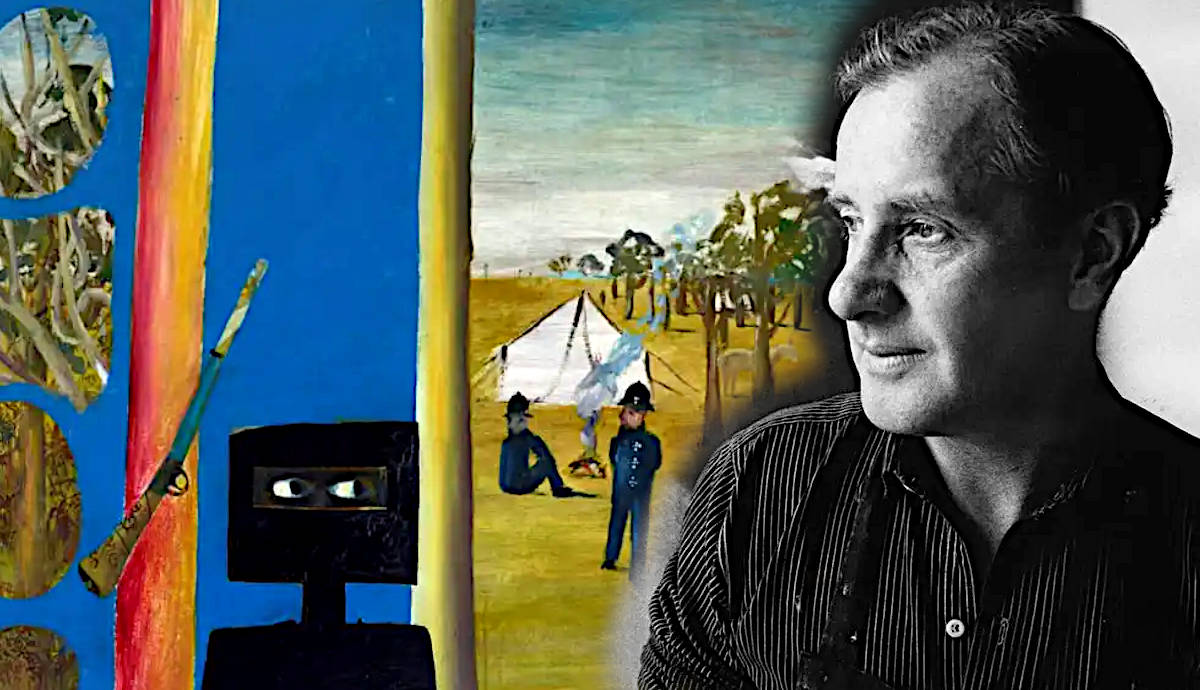
Few Australian artists have broken into the European and American art markets. One of those few masters is Sidney Nolan who is most well-known for his prolific series depicting notorious Aussie outlaw Ned Kelly.
An interesting personal life with a career kicking off during the tumultuous 1940s lent to an incredible career as an artist.
1. Sidney Nolan Entered the Workforce at Age 16

As a young man from the working-class suburb of Carlton in Melbourne, Nolan was the eldest son who left school at 14. He studied at technical colleges in design and crafts before starting work at Fayrefield Hats in 1933.
He made advertisements and display stands for the company using his eye for design and from 1934, he took night classes at the National Gallery of Victoria Art School.
2. He Was an Editor of a Surrealist Magazine

The magazine Angry Penguins came from the Surrealist group named the Angry Penguins. It was started by Max Harris in 1940 and led to a huge avant-garde Surrealist movement in Australia. The magazine mostly included poetry and Nolan was one of its editors.
Much of Nolan’s work could be characterized as Surrealist and he was heavily influenced by other modern artists such as Paul Cezanne, Pablo Picasso, Henri Matisse, and Henri Rousseau.
3. He Was Involved in a Ménage a Trois

As you start to explore Nolan’s personal life, it seems to be filled with dramatic romances and strange pairings. It began with John and Sunday Reed, art patrons who Nolan was close friends with.
Nolan married graphic designer Elizabeth Paterson in 1938 and the two had a daughter together. However, the marriage soon broke down because Nolan was getting more and more involved with the Reeds.
For some time, he lived with the couple in the home called Heide which would later become the Heide Museum of Modern Art. It was there that Nolan painted his now-famous series of Ned Kelly pieces.

He was engaged in an open affair with Sunday Reed but when she refused to leave John for him, Nolan married John’s sister, Cynthia Reed. So, yes – you read that correctly. Nolan married his mistress’s sister-in-law.
For years, Nolan continued to live in a menage a trois with the Reeds. Devastatingly, Cynthia ended up taking her own life in 1976 by overdosing on sleeping pills in a London hotel, although this was many years after Nolan had cut ties with the Reeds.
Two years after Cynthia’s death, Nolan married Mary Boyd who was previously married to John Perceval. Perceval was also connected to the Reeds as he traveled within the so-called “Heide Circle” of art patrons and curators.
This odd series of love triangles had a long-lasting effect on everyone involved. Still, who knows if Nolan’s most famous works would have ever seen the light of day had it not been for this time in his life with the Reeds.
4. He Is Known for Paintings of Historical Australian Subjects

Nolan was known to paint many fascinating legendary figures who litter Australian history. Some of these figures include the explorers Burke and Wills, and Eliza Fraser. Still, his most famous series, as we’ve mentioned, features Ned Kelly, the infamous bushranger and outlaw.
In an interesting example of how life circumstances can influence a career, the Ned Kelly series that was painted from 1946 to 1947 were left at the Reed’s home when Nolan stormed out in an emotional huff.
At first, he told Sunday she could keep whatever she wanted of his paintings, but later demanded they be returned. Since Sunday worked on many of these pieces with Nolan, she returned all but 25 Kelly paintings.
However, eventually, in 1977 the remaining work from the series was given to the National Gallery of Australia.
Although the effects of the Depression and World War II were felt globally during this time, Nolan made a conscious effort to concentrate on Australian nationalism versus depicting people’s struggle and strive.

The intensity of the colors Nolan used in his landscapes of the outback was unique and in terms of art history, critics claim that he rediscovered these landscapes. The bush and deserts of the land down under is notoriously difficult to paint but Nolan made them into his masterpieces.
5. Sidney Nolan Deserted the Australian Army during WWII

Interestingly, Ned Kelly was probably a metaphorical self-portrait of Nolan himself. Kelly was an outlaw and so was Nolan.
When he was given orders that he was to be sent to Papua New Guinea to serve on the front lines during World War II, Nolan went absent without leave. Desertion is a serious crime and he changed his name to Robin Murray while on the run.
The Ned Kelly series would go on to be an international sensation, proportions of which most Australian artists never even scratch the surface. The series was shown at the Musee National d’Art Moderne in Paris, the Museum of Modern Art in New York, and Tate Modern in London, among others.
Nolan moved to London in 1951 and traveled widely throughout the rest of his life including stops in Africa, China, and Antarctica. He died at age 75 on November 28, 1992.





